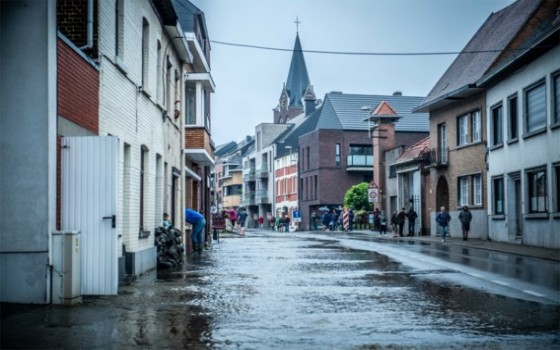
European report: Pollution levels remain very high, especially from harmful noise and waste generation. 15 regions in Austria, Finland, France, Germany and Sweden have the lowest pollution levels.

- Europe and Arabs
- Monday , 3 March 2025 10:44 AM GMT
Brussels: Europe and the Arabs
The European Commission and the European Environment Agency (EEA) published today in Brussels the second Zero Pollution Monitoring and Forecast Report, which provides an overview of the EU’s work to achieve the Zero Pollution targets for 2030. It also published its fourth Clean Air Outlook report.
The reports show that EU policies have contributed to reducing air pollution, the use of pesticides and plastic litter in the sea. However, pollution levels remain very high, particularly from harmful noise, the release of microplastics into the environment, nutrient pollution and waste generation. According to the reports, much stronger action is needed in the EU to achieve the 2030 pollution reduction targets.
The principles of Zero Pollution must be integrated into all policies and efforts at all levels to ensure further progress. In this context, strengthening the EU’s circular economy will help reduce resource consumption and thus alleviate pressures on ecosystems and human health. Finally, working towards Zero Pollution, in particular through the Zero Pollution Action Plan, will support the sustainable transformation of the EU economy and make it more competitive.
Progress towards 2030 targets but pollution levels still too high While progress towards the six ‘zero pollution’ targets remains mixed, pollution from marine litter, pesticides and antibiotics is declining, according to the Zero Pollution Monitoring and Outlook report. Air quality has also improved across Europe, supported by regulatory developments and emissions reductions, leading to a significant reduction in premature deaths. However, the number of deaths from polluted air remains too high. In addition, persistent pollution, particularly from ammonia and nitrogen oxides, continues to threaten the EU’s ecosystems. This is echoed in the fourth Clean Air Outlook report, which highlights that while EU air pollutant emissions continue to fall, air quality poses a serious risk to health and the quality of EU ecosystems. Both reports show that more work is needed to further reduce air pollution. The Zero Pollution Monitoring and Outlook report also finds that levels of pollution from harmful noise, microplastics, nutrients and waste remain too high. Regarding noise pollution, more efforts are needed, especially in urban areas, to reduce the number of people suffering from chronic disturbances due to transport noise. Regarding microplastics, further measures are needed to address this source of pollution. In addition, nutrient losses have remained largely unchanged, particularly due to ongoing challenges from agricultural runoff and fertiliser use. Regarding waste, more efforts are also needed, as waste generation continues to increase in the EU. The report clearly shows that more work is needed to achieve the EU’s ambition of achieving zero pollution. Full implementation and enforcement of EU environmental legislation is therefore crucial to achieving the 2030 zero pollution targets, as set out in the Zero Pollution Action Plan. On the legislative front, the EU has already taken steps with the revision of the Industrial Emissions Directive, the Ambient Air Quality Directive, the Urban Wastewater Treatment Directive, the Waste Framework Directive, the Water Framework Directive and the Mercury Regulation. The new Nature Recovery Regulation will also contribute to further reducing pollution pressures on ecosystems and increasing the resilience of ecosystems in general. To tackle microplastic pollution, the Commission presented in 2023 a proposal for a regulation on preventing microplastic losses to the environment. Once adopted, it will help achieve this pollution target in the Zero Pollution Action Plan.
Zero Pollution Dashboard
The two reports are accompanied by the first Zero Pollution Dashboard, which shows the progress made by EU regions and all capitals in achieving cleaner air, water and soil.
The dashboard compares regions with each other and with the EU average. The comparison is based on several environmental pollution indicators that address health, the protection of ecosystems and biodiversity, as well as production and consumption.
The dashboard highlights 15 regions in Austria, Finland, France, Germany and Sweden that currently boast the lowest pollution levels.
The Zero Pollution Monitoring and Outlook report was produced in collaboration with the European Environment Agency and the Commission’s Joint Research Centre. The monitoring and outlook assessment serves as a regular biannual check on the progress made by Member States towards achieving the Zero Pollution targets. This report will also guide future policies designed to support the ambition of Zero Pollution – to reduce pollution to the point where it no longer poses a risk to human health and the environment by 2050. To achieve a clean and healthy planet, the Zero Pollution Action Plan was launched in 2021 with key targets to accelerate pollution reduction. The Commission has launched nine flagship projects and 33 dedicated actions to prevent and reduce pollution, including in particular the Zero Pollution Package for clean air and water. Pollution contributes significantly to a range of health problems and premature deaths. There are clear inequalities in exposure to and impacts of pollution. Citizens in lower socio-economic groups tend to be more exposed to pollution, and vulnerable groups such as children and the elderly are disproportionately affected. This can be prevented by reducing pollution levels in the environment and should be considered as part of future preventive health measures in Europe.












No Comments Found